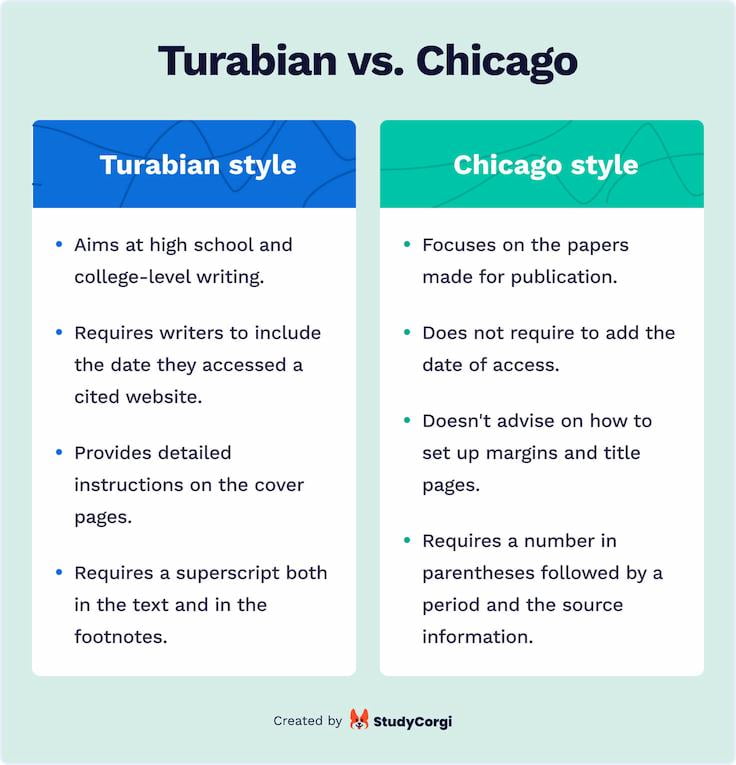✨ Why Use a Turabian Title Page Generator
Turabian title page generator has a lot of benefits that make it stand out among other online tools. For example:
- It saves you time. You get your title page ready in a few clicks.
- It is free. You get unlimited attempts to use our tool with no hidden payments.
- It improves the quality of your paper. You will never confuse the Turabian style with the Chicago one.
- It is 100% online. You can use any electronic device to make a perfect title page.
🆚 How Is Turabian Style Different from Chicago?
In 1937, Kate L. Turabian wrote a manual to guide students in citing and referencing their research papers. Acknowledging the needs of students, she modified the Chicago style and came up with a new one. Nowadays, the Turabian system is used by social sciences, natural sciences, and humanities researchers.

The key differences between the Turabian and Chicago styles include the following:
| Feature | Turabian | Chicago |
|---|---|---|
| Academic level | Turabian style aims at high school and college-level writing. | Chicago focuses on the research papers made for publication. |
| List of references | The Turabian style requires writers to include the date they accessed a cited website. | Chicago style doesn't consider it to be necessary. |
| Instructions | Turabian provides detailed instructions on the cover pages. | Chicago style doesn't advise on how to set up margins and title pages. |
| Notes numbering | Turabian requires a superscript1 both in the text and in the footnotes; after the superscript number comes the source (1 StudyCorgi). | Chicago requires a number in parentheses followed by a period and the source information (1, Studycorgi.com). |
🤓 Turabian Style Title Page – Requirements
Check that your title page is correctly formatted if you want to impress your readers. To help you with that, we made the list of necessary elements and formatting requirements for the Turabian-style title page.
Elements
-
The title of your paper
The title of your research should be capitalized, centered, and located approximately one-third down the page.
-
The subtitle of your paper
The subtitle is not a necessary part of the Turabian title page. However, you might add it below the title to provide readers with a better understanding of your topic.
-
Your full name
You need to mention your first and last name near the bottom of your page.
-
Course name
Put down a class or a course name on a separate line. Check the syllabus if your course has a number, and don't forget to mention it.
-
Supervisor's full name
When referring to your supervisor or a teacher to whom you submit the paper, don't miss out on their academic degree.
-
The due date of your paper
The final touch is adding the date when you will submit your paper at the very bottom of the page.
Formatting
- The text on your title page should be centered, double-spaced, and match the font of your work.
- Don't put the page number on the cover of your writing. Mark the following page with the number two.
- The essential words in your paper's title should be capitalized and written in bold. Follow the main title with a colon if you want to add a subtitle on a separate line.
- Any other information regarding your name, course, and supervisor should be added approximately ⅔ down the page. Each new piece of information starts on a separate line.
- Your paper's due date should be presented in the following format – Month Day, Year.
📝 Methods for Documenting Sources
Like the Chicago style, the Turabian offers two different methods of citation: author-date and the notes-bibliography. Consider their key features to see which way will suit your paper better.
The Author-Date (AD) System
The first method uses in-text citations (similar to APA style) that correspond with a final reference list.
-
In-text references include the year of publication in parentheses after the author's name and the page numbers you're referring to at the end of the sentence.
Hillis Miller (2002) argues that reading literature is a part of our basic human need to create imaginary worlds and to have stories (34). -
The list of references is usually placed at the end of the paper and is double-spaced and alphabetized.
Miller, Hillis. 2002. On Literature. 2nd ed. London: Routledge.
The Notes-Bibliography (NB) System
The second method uses footnotes to locate citations at the bottom of a page or the very end of the paper. These footnotes refer to the more detailed and organized in alphabetical order bibliography.
-
The notes are placed at the bottom of each page and are separated by a typed line. They can also be placed on a separate page if instructions allow it.
Keith Rayner, Psychology of Reading (New York: Psychology Press, 2011), 8. -
The bibliographic form of the notes is alphabetized according to the authors' last names. Unlike the notes, the bibliography doesn't mention the specific pages from where the information was taken.
Rayner, Keth: Psychology of Reading. 2nd ed. New York: Psychology Press, 2011.
🖇️ References
- Title Page Example - Chicago/Turabian Formatting and Style LibGuide - LibGuides at Donnelly College
- Chicago/Turabian: Structure and Formatting of Specific Elements | Conventions of College Writing
- General Format // Purdue Writing Lab
- How to Write Bibliography for Assignment: Tips on Working with Your Sources
- Chicago/Turabian Documentation; The Writing Center; UW–Madison